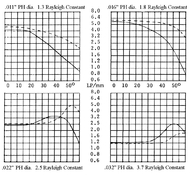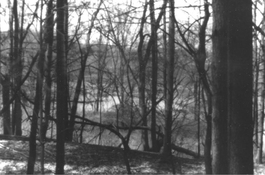I’d like to get into pinhole photography with my 5x7 field camera but have questions about adjusting the bellows. I get that adjusting the bellows doesn’t alter the focus, but does it alter the field of view or focal length? That is, will moving the rear standard back away from the front change the field of view more from wide angle to telephoto? Or, is there a single ideal distance between the standards for pinhole on a bellows camera and, if so, how is that to be determined?
Just to summarise my posts and maybe some more commentary:
- yes, there is a single distance that is optimal for a given pinhole size, if distance is not correctly set for whatever pinhole size used, results will not be optimal, this is technical best I am referring to
- once you get the right distance, you will need to make a mark for future use, so you can repeat the setting for pinhole it was set up for
- in order to measure the distance (starting with what calculators give), it is best to measure internally from front standard mounting plate to ground glass, then compensate that for the actual location of pinhole plate against that front mounting plate, so you end up with distance between pinhole itself and ground glass
- calculators already mentioned will give good to very good results, key is to ensure that pinhole size used is the one as stated, with purchased pinhole, they are likely close enough to what they say they are, but it would not hurt to check upon receipt, good makers WILL provide actual size of what was shipped (so when you order say a 0.3mm pinhole, what you will receive may say i.e. 0.323 mm or something else, if it only says 0.3 then it is not likely accurate), how far off is still good enough is a matter of desires, taste, and wanting to be as exact as possible
- some disappointment form what a specific pinhole produces comes from not examining the pinhole and only relying on either "method" used in making it (assuming drill bit used produces that size pinhole, it did not), or pinhole provider's data
- quality of pinhole is important to get best resolution, when viewed under microscope it is clear what the problem is, edge artefacts that can be significant, lack of roundness, all play part in what can be achieved on film, material thickness is also very important,
Pinhole vs. lens is like an open gate vs. heavily screened one.
Lens corrects what is happening with light rays as they pass through each subsequent element and how they ultimately coincide at film plane.
Pinhole is not capable of doing that, is not correcting for anything, so light rays come through and fall onto film plane as they may. Pinhole size and shape, combined with distance to film plane, determine how it all records on film.
In most basic sense, each tiny part of what makes up each detail of a scene is projected onto film plane as a "cone of light", which as it passes through the hole continues to expand in size until it reaches film plane.
The best resolution is achieved when two neighbouring "cones" are just adjacent, not separated nor overlap[ping. This is where focal distance makes its mark, and cannot be calculated accurately enough, it must be tested and adjusted for (again, from pure technical best standpoint). How important this part is, it is up to each individual to determine. And there are three basic pinholers out there (later on this).
These "cones" also distort in shape as they move away from on-axis position, something that is part of pinhole image projection complexity, and only partially controllable.
Vignetting has two categories: physical one, which is basically not the case with pinhole projection due to very wide angle of view (call it some 120 degrees, even if it depends on several factors and not a fixed value).
Vignetting that does apply to pinhole photography is from light fall off. It may be significant, depending on how all pieces come together in camera design. In order to minimise light fall-off vignetting:
- pinhole size and corresponding focal distance can be deliberately chosen to project at film plane smaller portion of what pinhole is capable off (so if you have your 5"x7" set up as best possible for pinhole size / focal distance, then use roll film back to make an image say 6x6, you may not notice much vignetting, if any, But then you loose in some other areas by doing so, to much to cover at this point though.
- use curved film plane instead, which has a benefit of minimising light fall off issue and lessens geometric distortion of said "clones of light" at film plane. Unfortunately it also introduces geometric distortion of its own for most parts of a scene, and of course adds film plane design complexity
- importance of both of these points is certainly debatable as pinhole imaging is often equalised with vignetted and distorted outcome
in all this, how does one choose which pinhole size to use? Bigger one will admit more light, so exposure times will become much shorter, but resolving ability will drop. So generally the smaller the negative the smaller the pinhole (until diffraction puts a stop to going smaller), so when that negative gets enlarged, things will continue to look acceptable. With larger negatives there is more "room" to sacrifice on recorded detail and allowing better control of what is being recoded (very long exposures directly affect what things look like, some won't even show up i.e some moving objects).
In the end, pinhole photography is a game of compromises chosen to achieve a desired result, Some of it can be well controlled, some will remain in the doldrums of chance.
As you examine pinhole photographs, you will have noticed wide range of outcomes, from hard-to-believe "sharpness" to hardly recognisable detail.
In my view there are three basic types of pinhole shooters:
- whatever makes an image is what I want - does not matter much how I got there, I have an image, I call it art and stop right there, this group is one that uses pinholes of all kinds of shapes, film plane in all kinds of shapes, as result the outcome is not predictable, some images come out very interesting, some far from it, but it is all a matter of personal approach and subjective seeing, so whoever likes this I can appreciate it
- get in the main pinhole groove - use recommended pinhole, set it at recommended distance, buy a ready made camera, and shoot away, good chunk of this approach produces good to excellent images
- tinker till you die - trying to achieve technical limits of pinhole image making, a. partly futile battle, which can be quite rewarding, and with biggest benefit being ultimate understanding of how pinhole does what it does, easy later to depart from it, just like it takes knowing the rules in order to break them
To give one example of additional complexity, different sizes of pinhole or different pinhole to film distances will be optimal for different wavelengths of light. One of the ways of improving resolution is to either filter out a bunch of different wavelengths, or use film with limited spectral sensitivity.
This 2008 thread contains a useful discussion of the complexities. Unfortunately some referenced links are no longer current.
https://www.photrio.com/forum/threads/how-to-improve-resolution-in-pinhole-camera.35133/
Yes, absolutely correct. But without going that far, things can be improved by getting things lined up properly. I am only referring to getting optimal focal distance nailed as best possible.









